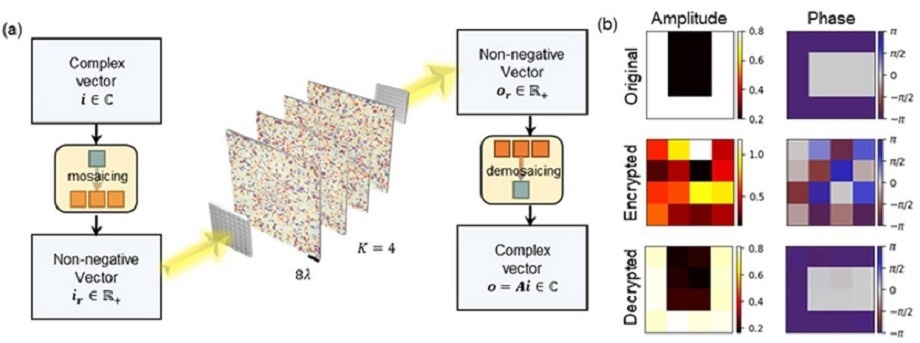Modern neural networks mostly use linear operations like convolutions and matrix-vector multiplications. Although there are specialist processors for these tasks, like as GPUs and TPUs, their power and bandwidth are limited. Because of its huge bandwidth, calculation speed, and inherent parallelism, optics is a preferable choice for these types of processes.
 Spatially incoherent diffractive optical processors can handle data beyond non-negative values, potentially making them valuable in diverse scenarios, such as visual encryption and autonomous vehicle navigation. In a spatially incoherent diffractive network model, a complex-valued element of the input vector is represented by a set of real, non-negative intensity values (mosaicing) and the resulting input intensity pattern is fed into the incoherent diffractive network (a). At the output, a complex-valued vector element is synthesized from a predefined set of pixels (demosaicing). To demonstrate an application, the letters ‘U’ and ‘C’ are encoded in the amplitude and phase of a complex image, which is encrypted digitally and thereupon decrypted using the spatially incoherent diffractive optical network (b). The decrypted complex image matches the original image very well. Image Credit: Ozcan Lab @ UCLA
Spatially incoherent diffractive optical processors can handle data beyond non-negative values, potentially making them valuable in diverse scenarios, such as visual encryption and autonomous vehicle navigation. In a spatially incoherent diffractive network model, a complex-valued element of the input vector is represented by a set of real, non-negative intensity values (mosaicing) and the resulting input intensity pattern is fed into the incoherent diffractive network (a). At the output, a complex-valued vector element is synthesized from a predefined set of pixels (demosaicing). To demonstrate an application, the letters ‘U’ and ‘C’ are encoded in the amplitude and phase of a complex image, which is encrypted digitally and thereupon decrypted using the spatially incoherent diffractive optical network (b). The decrypted complex image matches the original image very well. Image Credit: Ozcan Lab @ UCLA
Diffractive networks, or diffractive deep neural networks (D2NN), are a new type of optical computing architecture. These task-specific networks could passively conduct computing operations at the speed of light through an ultrathin volume. They are built from spatially designed thin surfaces.
The diffractive optical network’s physical hardware is made from the optimum diffractive surfaces, which are obtained by a one-time design procedure that teaches the surfaces’ spatial properties.
Aydogan Ozcan, UCLA’s Chancellor’s Professor and holder of the Volgenau Chair for Engineering Innovation, and his colleagues have published a study in Advanced Photonics Nexus outlining a technique for carrying out complex-valued linear operations with diffractive networks in the presence of spatially incoherent light.
The same group’s previous research demonstrated that diffractive networks with enough degrees of freedom may use spatially coherent light to execute any complex-valued linear transformation.
On the other hand, if the matrix components defining the transformation are real and non-negative, these networks may execute arbitrary linear transformations of input optical intensities under spatially incoherent light. Spatially incoherent diffractive processors are becoming more and more necessary to handle data that goes beyond simple non-negative values, as spatially incoherent illumination becomes increasingly common and accessible.
Researchers at UCLA have expanded the capabilities of spatially incoherent diffractive networks to handle complex numbers by integrating pretreatment and postprocessing procedures to represent complex numbers by a collection of non-negative real numbers.
They showed that if there are enough optimizable phase features in the diffractive design—which must scale up with the dimensions of the input and output complex vector spaces—such incoherent diffractive processors can be intended to perform an arbitrary complex-valued linear transformation with negligible error.
By employing spatially incoherent diffractive networks for encryption and decoding complex-valued images, the researchers demonstrated the practical application of their innovative technique. These processors have potential uses beyond visual image encryption, including analyzing natural scenes in autonomous automobiles at extremely fast processing speeds and minimal battery consumption.
Spatially incoherent diffractive processors are useful in a variety of settings due to their versatility in handling data that goes beyond non-negative values.
Journal Reference:
Yang, X., et. al. (2024) Complex-valued universal linear transformations and image encryption using spatially incoherent diffractive networks. Advanced Photonics Nexus. doi:10.1117/1.APN.3.1.016010